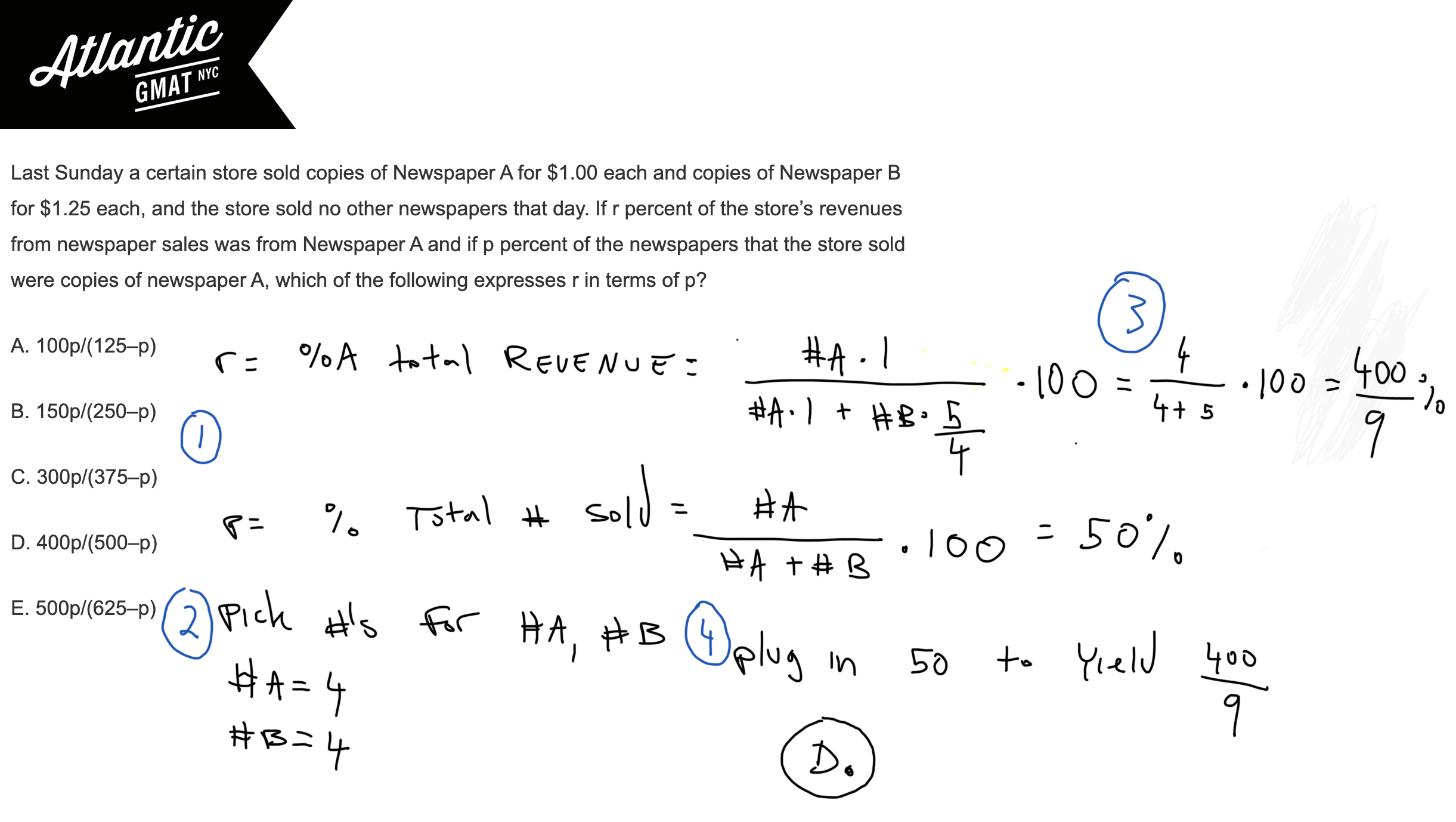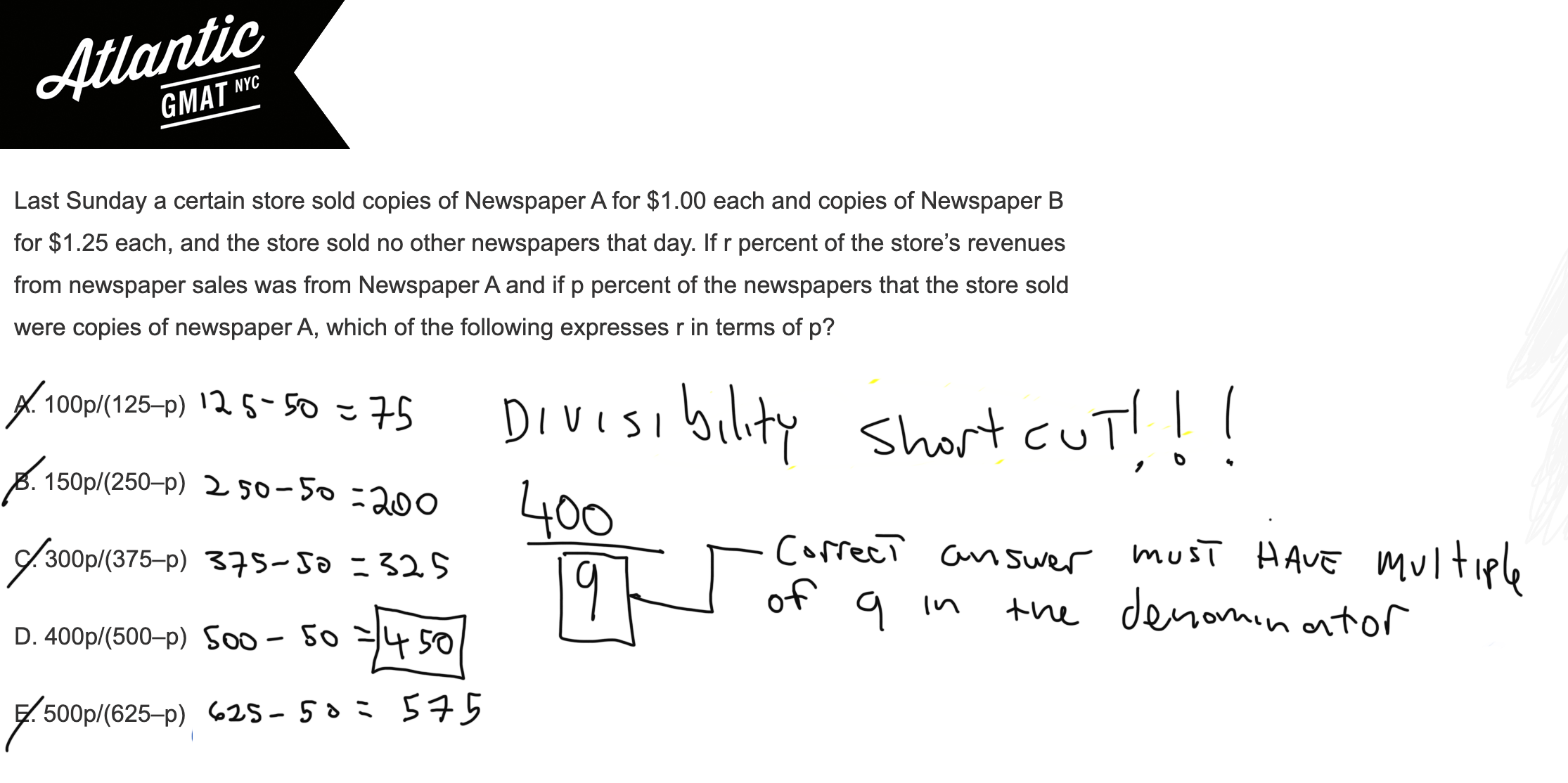Last Sunday a certain store sold copies of Newspaper A for $1.00 each and copies of Newspaper B for $1.25 each, and the store sold no other newspapers that day. If r percent of the store’s revenues from newspaper sales was from Newspaper A and if p percent of the newspapers that the store sold were copies of newspaper A, which of the following expresses r in terms of p? GMAT Explanation, Video Solution, and additional practice questions!
Last Sunday a certain store sold copies of Newspaper A for $1.00 each and copies of Newspaper B for $1.25 each, and the store sold no other newspapers that day. If r percent of the store’s revenues from newspaper sales was from Newspaper A and if p percent of the newspapers that the store sold were copies of newspaper A, which of the following expresses r in terms of p?
A. 100p/(125–p)
B. 150p/(250–p)
C. 300p/(375–p)
D. 400p/(500–p)
E. 500p/(625–p)
OK, so this Newspaper Store question is a big one. We see this all the time in the course of GMAT tutoring. It’s dense. No matter how you slice it’s a bit time consuming. Understand it. Yes you should. Solve it on your GMAT? That’s a maybe.
That does’t mean run and hide whenever you see a dense word problem. Still, dense + variables in answer choices might be an indicator that you could be in for the long haul even if you ultimately succeed. Again: long word problem does not equal auto skip. Here’s a wordy GMAT remainder/ divisibility question from the GMAT official guide that while considered tough can be solved pretty easily provided that you have a decent method.
Back to last Sunday at the newspaper store! First step: read carefully. Don’t skim. Digest as you read BUT try not to solve as you read. We need to get the setup before we follow through.
Now let’s go ahead and define the question. Again, let’s not calculate or worry about the numbers but focus on the story (the nouns).
Here’s the question: which of the following expresses r in terms of p?
Not necessarily a straightforward thing to define in a useful way. In this case I’d start by defining r and p separately and then see how we can connect them. You can start with either r or p but generally aim to start easy. I’d say p is slightly simpler so let’s start there.
p = the percent of the newspapers that the store sold were copies of newspaper A
Great. Easy. So let’s add some variables. #A and #B. So P = (#A/(#A + #B))*100. Why are we multiplying by 100? It’s a percent! Without the 100, the fraction is just a decimal. To get the percent you need to multiply by 100. This step can range from unimportant to critical. If picking numbers and plugging back into answer choices multiplying by 100 for percents is very important. If you don’t multiply by 100 your result won’t match any of the answer choices.
r = the percent of the store’s revenues from newspaper sales was from Newspaper A. OK. Not bad. We don’t need any additional variables for this because we have the per unit prices for Newspapers A and B.
r = (#A(1)/(#A(1) + #B(5/4)))*100
Now you could try to equate those and isolate r. r in terms of p just means, how do you transform p to equal r? That said, I’d consider picking numbers. Why? Well, if you have the numbers. Meaning, if you knew the values of r and p would it be easy to equate one with the other? Meaning, if r were 4 and p 2 can you relate those? Sure you could! r = 2p. If the question would be easier if you had the numbers then go ahead and pick some! Clearly you can’t always pick numbers. There are generally two scenarios that make this possible:
- You have variables in the answer choices
- You have proportions in the answer choices
That doesn’t mean if you are in scenario 1 or 2 that you should always pick numbers. It’s just that those scenarios tend to make it possible and certainly suggest that you consider picking values.
Ok, so what variables do we have? #A and #B. We’re just missing the number sold. Do we have constraints? Not really. Don’t pick negative numbers or 0 because at least 1 newspaper was sold. You could pick any positive integer.
I’d stick to smaller numbers and potentially set up your expression so you create easy arithmetic. In this case we the 5/4 from the price of Newspaper B. I’d try to cancel the 4 in the denominator. Why not make #B = 4. And, while we’re trying to make the GMAT easy, let’s make #A also equal to 4 so we know p, the percent of the newspapers that the store sold were copies of newspaper A, is 50%. No calculation needed.
Now let’s do r: (4/(4 + (5/4)*4))*100 = 400/9
Perfect. So r = 400/9. That’s what we want to transform p into. Simpler way to put it: plug p (50) into the answer choices and the correct answer will yield 400/9. Now, you could do the arithmetic for all of the answer choices but there is a shortcut if you’ve picked numbers and are plugging back into the answers. Use divisibility. We know that the correct answer will simplify to 400/9. So I’d look at the denominator, 9. We know that the denominator if the correct answer, even before being simplified, must be a multiple of 9. So let’s start by looking only at the denominators and eliminate any choice that doesn’t have a denominator that is a multiple of 9.
A. 100p/(125–p). 125-50 = 75
B. 150p/(250–p). 250-50 = 200
C. 300p/(375–p) 375 – 50 = 325
D. 400p/(500–p) 500-50 = 450
E. 500p/(625–p) 625-50 = 575
Just because the denominator is divisible by 9 doesn’t mean it is the correct answer. It could be that after using the divisibility trick that you’re left with a couple of choices. That’s fine. You can then plug in the rest for the ones you’ve got left. You can also use magnitude to decide between them. Sometimes choices that pass the divisibility test are either way too big or small to be the correct answer.
In terms of the algebra answer choice D means that r = 400p/(500–p).
Video Solution: Last Sunday a certain store sold copies of Newspaper A for $1.00 each and copies of Newspaper B for $1.25 each, and the store sold no other newspapers that day. If r percent of the store’s revenues from newspaper sales was from Newspaper A and if p percent of the newspapers that the store sold were copies of newspaper A, which of the following expresses r in terms of p?
Additional GMAT Word Problem, Percent Change, Picking Numbers, Practice Questions
Here’s a very similar tough word problem with a bunch of variables from the GMAT Official Guide: Last year the price per share of Stock X increased by
And another question from the Official Guide that’s similar-ish in that you can pick numbers and use the divisibility shortcut for eliminating answer choices. It’s also one that tutoring students tend to mis-interpret. During a trip, Francine traveled x percent of the total distance
Here’s another very challenging word problem from the GMAT Official Guide: Last year, a certain company began manufacturing product X and sold every unit of product X that it produced. It’s a data sufficiency question and neither features percent change nor picking numbers but it has the same level of density and difficulty. It requires a great setup. It’s also one that you might skip (even though you should understand 100% how to get it through it in practice).
Here’s a word problem from GMAT question of the day on which you can practice picking numbers.


